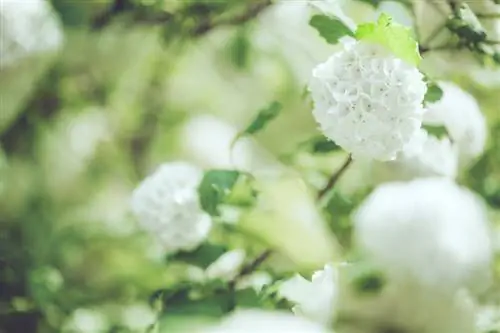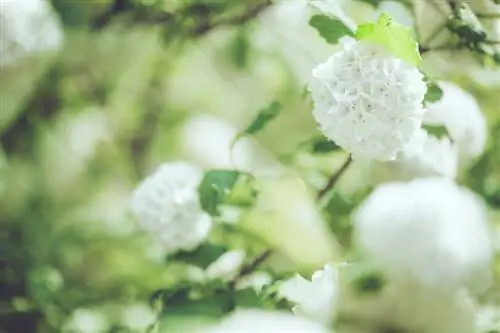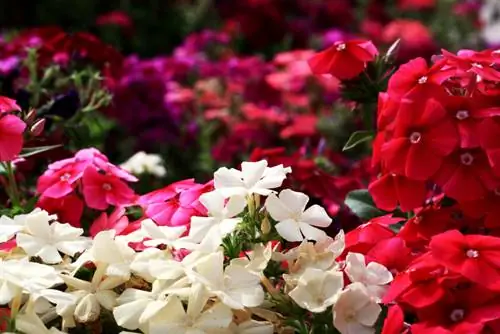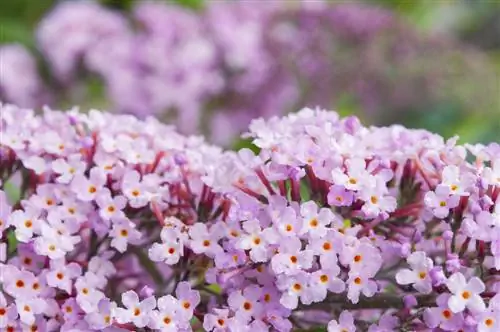- Author admin [email protected].
- Public 2023-12-25 17:45.
- Last modified 2025-01-23 11:20.
The ornamental tree with the apt name snowball enriches the garden with fragrant flower balls and decorative foliage. Thanks to its diverse biodiversity, the enchanting viburnum genus leaves no gardener empty-handed. How good that the multi-faceted shrubs pull together when it comes to planting and care. Open questions about flourishing cultivation receive well-founded answers here.

How to care for a snowball in the garden?
The snowball (viburnum) is an ornamental tree with fragrant flower balls and decorative foliage. Care tips include: slightly moist soil, regular organic or liquid fertilizer, phosphate-based fertilizer for flowering, pruning after flowering, thinning and light winter protection.
Planting snowballs correctly
In autumn or spring it is time to plant a viburnum. To do this, dig a planting pit with twice the volume of the root ball. Place the excavated soil in a wheelbarrow to mix in compost, leaf mold or horn shavings. Meanwhile, the snowball doesn't sit idle, but absorbs enough water in a bucket until no more air bubbles rise. Only then do you pot up the young tree and plant it in the middle. Please make sure that the root collar is not covered with soil. Press the soil firmly with your hands, water generously and mulch with leaves or bark mulch.
Care tips
With this care program you can meet the requirements of the numerous varieties within the broad viburnum genus:
- Keep the soil constantly slightly moist
- During the growth and flowering period, fertilize organically (€56.00 on Amazon) or liquid every 2-3 weeks
- Preferably administer a phosphate-rich fertilizer to promote flowering
- Light pruning immediately after flowering and thinning out thoroughly
Light winter protection is advisable by covering the root disc with leaves, brushwood, bark mulch or straw. Young trees are given a cover made of air-permeable fleece. On planters, a cover made of bubble wrap or jute ribbons and a wooden base keep the freezing frost away from the root balls.read more
Which location is suitable?
The majority of snowball species and varieties prefer a sunny and protected location. Specialists are available for low-light locations, such as the native Viburnum opulus. The consensus among ornamental shrubs is that they do not like to be ruffled by strong winds. The space in a wind lock also causes considerable problems in winter.read more
The correct planting distance
Adjust the planting distance to the expected growth height and width. Some of the most beautiful viburnum bushes grow as wide as they are tall, such as the hybrid 'Eskimo' at 150 cm or the mighty 'Roseum' at 400 cm. Since annual shape and maintenance pruning is not always mandatory, it has proven useful in practice to set half the growth width as the minimum distance.
What soil does the plant need?
A snowball thrives in any good garden soil that is nutrient-rich, humus-rich and well-drained. In addition, the ornamental tree feels comfortable when it can extend its roots in fresh, moist soil that is not threatened by waterlogging.
When is flowering time?
The snowball gives us a wide variety of species and varieties with individual flowering times. With the help of a clever combination, the pink and white flowers decorate the garden all year round. The following examples may serve as your inspiration:
- Winter snowball (Viburnum bodnantense): flowering period from October to March
- Spring viburnum (Viburnum burkwoodii): flowering period from March to April
- Woolly viburnum (Viburnum lantana): flowering period from May to June
- American viburnum (Viburnum nudum): flowering period from June/July to August/September
So that the red and black berries continue to thrive, do not cut off the withered flowers. The birds of the garden will thank you.read more
Cut snowball correctly
Cut back the ornamental tree immediately after flowering. At least the withered flowers are cut off along with the stem. The extent to which you shorten the branches depends on your personal decision and the variety you are cultivating. In any case, the shrub is thinned out by cutting off dead wood and stunted shoots at the base. Starting with the fourth year of growth, remove 3-4 of the oldest branches completely every 2 years as a permanent rejuvenation measure. If you have decided to let the decorative berries sprout, this date will be postponed accordingly.read more
Pouring snowball
Since viburnums, as shallow-rooted plants, prefer fresh, moist soil, adjust the water balance to the respective needs. If the soil has dried out, water generously until no more moisture is absorbed. Before the next watering session, wait until the thumb test shows dried substrate again. In the warm season and when the flowers and leaves are in full bloom, you will be on your way to your snowball much more often than in winter.
Fertilize snowball properly
On bushes in nutrient-rich garden soil, monthly fertilization with leaf compost, horn shavings or horse manure covers the needs. We recommend using a phosphorus-rich liquid fertilizer in the pot, which you should administer during the growth and flowering period according to the manufacturer's dosage instructions. Please note that there is no nutrient supply during the dormant growth period of a viburnum bush.read more
Pests
You will rarely have to complain about pest infestation on viburnum. If problems arise, the omnipresent aphids are usually behind it. Therefore, regularly examine the top and bottom sides of the leaves to see whether brown, yellow, black or white lice have settled there. In the early infestation stage, resorting to chemical treatment is unnecessary, as the classic soft soap solution is more effective than any insecticide. Mix 1000 ml of water with 15 ml of pure soap and add a few drops of spirit. Spray the infected plant with this mix every 2 days until the pests have disappeared.read more
Wintering
They are all hardy. However, there are differences in the degree of frost resistance of a viburnum. Since an exact classification is no longer possible with numerous hybrids, we recommend the following precautions for an undamaged winter period for reasons of caution:
- Cover the root disc with autumn leaves, straw or conifers
- Wrap planters thickly with bubble wrap, fleece or jute ribbons
- Place pots on cold-insulating material, such as wood or Styrofoam
In harsh winter locations and on young plants, you can also put a breathable hood over the branches. Since winter bloomers and evergreen varieties constantly evaporate water, water them even during the cold season when there is no snow or rain.
Propagate snowball
When it comes to propagation, nurseries and hobby gardeners agree. With head cuttings you can grow new viburnum easily and reliably. If the bush is full of sap, cut off non-flowering, semi-woody shoots below a leaf node that are 10-15 cm long. Remove the leaves from the lower half and put the offshoots in pots with a lean substrate. In a partially shaded, warm location, keep the soil slightly moist while the cuttings are busy rooting. If necessary, repot your young plants until autumn or spring whenever the roots have penetrated the growing container. From a growth height of 20 cm, apply a diluted liquid fertilizer every 2-3 weeks. Repeated trimming of the shoots promotes extra bushy growth and a rich abundance of flowers.read more
How do I transplant correctly?
Viburnums can easily cope with a change of location within the first 5 years of life. The most important premise is that you transplant the tree during the leafless period. In addition, an extensive and regular water supply subsequently makes an important contribution to renewed rooting.read more
Snowball in a pot
Numerous varieties are wonderfully suitable for your creative design ideas in the pot, such as the evergreen laurel viburnum (Viburnum tinus) or the compact hybrid 'Eskimo'. As a substrate, we recommend high-quality potted plant soil that is structurally stable enough to support a snowball as a standard tree. A water-conducting layer of clay shards or grit effectively prevents harmful waterlogging at the bottom of the pot. How to properly care for your piece of jewelry:
- Keep the substrate constantly slightly moist
- During the growth and flowering period, fertilize liquidly with a phosphorus-concentrated preparation
- Pruning immediately after flowering, in conjunction with thorough thinning
Regardless of the individual flowering time, we recommend winter protection for a viburnum in a pot. Wrap the pot in bubble wrap. If the look seems too sober for you, wrap colorful jute ribbons around it. Varieties that do not bloom in winter also receive a cover made of breathable fleece.
Is snowball poisonous?
All ornamental shrubs of the Viburnum genus contain toxic glycosides and toxic viburnin. This applies to leaves, flowers, shoots and especially unripe berries. The fruits lose their toxicity when fully ripe, but until then they pose a danger to small children and pets. Even consuming small amounts can trigger nausea, vomiting and even cardiac arrhythmias.read more
Beautiful varieties
The fantastic Viburnum genus presents us with wonderfully flowering varieties at different flowering times. The following selection presents you with the most beautiful snowball varieties so that you don't have to go without the distinctive flower balls at any time of the year.
- Gwenllian: Charming viburnum with evergreen leaves and white flowers from November to March; 100-150cm
- Dawn: Elegant winter snowball that drives away the sadness from the garden with pink and white flowers from January to March; 200-250cm
- Easter Snowball: Gives us pink buds and white flowers for Easter and wintergreen foliage; 150-300cm
- Aurora: Wonderfully fragrant, white flower beauty that awakens spring feelings in April and May; 100-180cm
- Eskimo: Impresses with spherical viburnum flowers from April to May and compact growth; 100-150cm
- Roseum: Premium variety that delights us with pink-white, double, 8 cm flowers in May and June; 250-350cm
- Mariesii: Creamy-white flowering Japanese viburnum from May to June with a pagoda-like habit; 150-200cm
- Blue Muffin: Stands out with creamy white flowers from May to June and steel blue berries in autumn; 100-150cm
- Pink Beauty: Lavish abundance of pink flowers from July to August and colorful autumn colors; 150-300cm






